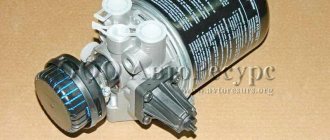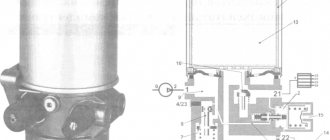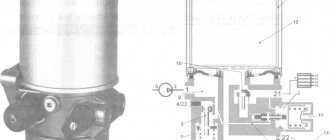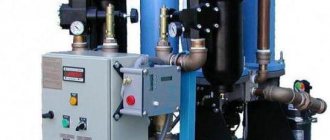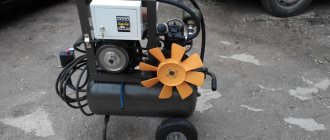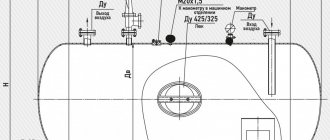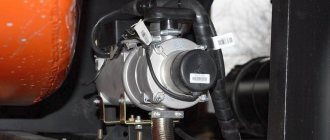9.1. Air Dryer.
An air dryer, shown in Figures 211 and 212, is installed in air brake systems to dry and clean the air coming from the air compressor and to regulate the operating pressure in the brake system.
Figure 211. External view and internal structure of the air dryer. Designations: 1 - Inlet; 2 - Control piston;3 - Outlet;4 - Channel;5 - Channel; 6 — Muffler;
7 — Exhaust; 8 — Exhaust valve; 9 — Moisture separation chamber; 10 — Check valve; 11 - Jet; 12 - Ring filter; 13 - Drying agent; 14 - Air regeneration receiver; 15 — Adjusting screw. Inlets: 1 - Supply inlet; 21 - Outlet (to the four-circuit safety valve); 22 — Branch (to the regeneration air receiver); 3 - Atmospheric output
The use of an air dryer eliminates the need to use moisture removal equipment based on additional cooling and automatic condensate drain valves, as well as additional antifreeze (alcohol) injection equipment.
The advantages of a dehumidifier over traditional air conditioning are as follows.
-There is no corrosion of brake system elements caused by condensation.
-The number of failures in the operation of components and assemblies of the brake system is reduced due to the absence of condensate and oil film.
- Low maintenance costs.
-Pressure regulation occurs in a zone of purified air, as a result of which the likelihood of malfunctions in the operation of the pressure regulator is reduced.
Air dehumidification occurs due to the adsorption of moisture at the molecular level by a drying agent (13). Compressed air is forced through the granular, highly porous powder. During this process, any water vapor in the air is deposited on the granules. To regenerate the powder, part of the dried air is discharged into the atmosphere, passing through the powder in the opposite direction. As a result of the decrease in pressure, the partial pressure of water vapor in the regenerating air (i.e., the dryest possible air) also decreases, which allows this air to absorb moisture deposited on the granules.
Figure 212. Structure of the dryer
Air dehumidification in the discharge phase.
The air supplied by the air compressor passes through the supply inlet 1 (the pneumatic circuit is shown in Figure 214) first through the ring filter (12), where it is pre-cleaned from contamination such as carbon deposits and oil. In addition, the air is cooled in the ring filter (12) and part of the moisture contained in it is collected in the moisture separation chamber (9). The air then passes through the granular powder (13) - where dehumidification occurs - to the check valve (10); opens it and passes through outlet 21 to the air receivers of the brake system. At the same time, through the jet (11) and outlet 22, a small air receiver (14) is filled for regeneration. Air purification and preliminary removal of moisture in the ring filter (12) has a positive effect on the service life and efficiency of the powder (13).
Air regeneration in the cleaning phase.
When the pressure in the brake system rises to an appropriate level, the so-called cut-out pressure, the integrated pressure regulator opens the relief valve (8). The air pumped by the air compressor and the compressed air from the air dryer are released into the atmosphere through the outlet (7) and the atmospheric outlet 3, while capturing the accumulated moisture, oil and most of the dirt particles settled in the filter.
Dry air from the regeneration air receiver (14) passes through outlet 22 and nozzle (11) and fills all free space. Penetrating through wet powder granules (13), air absorbs moisture deposited on the surface of the granules before being released into the atmosphere through the ring filter (12) and the discharge valve (8).
The check valve (10) prevents the reverse flow of compressed air from the air receivers.
Thanks to the integrated silencer (6), the noise generated when the dump valve (8) opens is significantly reduced. In this case, a multi-stage throttle muffler is used, the design of which protects against high-speed pressure pressure, which can cause contamination and thereby weaken the efficiency of the air dryer.
Operation of the integrated pressure regulator.
Due to the pressure in the receiver, the control piston (2) moves and the air passes through the channel (4). As soon as the pressure reaches the cut-out pressure, the control piston (2) moves to the right and opens the outlet (3). In this case, the control piston (2) closes the inlet (1) leading to the ventilation hole, no leakage occurs. As a result, compressed air is supplied through the channel (5) to the relief valve (8), opening it. As soon as the receiver pressure drops to the cut-in pressure level, the spring of the control piston (2) forces it to move to the left, thereby opening outlet (1) and closing outlet (3). The air above the exhaust valve (8) exits through the channel (5), inlet (1) and vent (15); the cleaning valve closes.
The shut-off pressure and excess pressure of the regulator are determined by the spring load and the movement of the control piston. Both values are achieved - largely independently of each other - by means of the adjusting screw 15.
In the event of a malfunction, the pressure regulator, the safety valve - consisting of a relief valve (8) and a valve compression spring (7) - ensures that the pressure in the receiver is limited, releasing the incoming air to the atmosphere as soon as the pressure reaches the opening pressure (emergency pressure).
To prevent freezing of the relief valve (8) under unfavorable weather conditions, use an electric heater installed in the air dryer body at the location of the relief valve (8) (not shown in the figures). The heater is turned on from the ignition switch, the temperature is controlled by an automatic built-in thermostat. Various modifications of the heater are possible. The heater is shown in Figure 213.
Figure 213. Appearance and internal structure of the heating element
When the ignition switch is turned on, the heating is controlled by a reverse current thermal relay. To prevent the battery from being discharged when the vehicle is parked, the heating current must be turned off when the ignition switch is turned off. The heater can be built in additionally.
Installing an air dryer increases the volume of the brake system (volume of the air dryer plus the regeneration air receiver). This increases the filling time of the brake system by approximately 3% to 7%. It is therefore necessary to check whether the permissible filling time of the brake system is being maintained.
In addition, the average duty cycle of the pressure regulator when installing an air dryer should not exceed 50%, since if the pumping time is increased, there may not be enough time for regeneration. At a duty cycle of 50% to 60%, it is not possible to install an air dryer.
Device
The air flow drying device includes such elements as:
- control type piston;
- release device;
- muffler;
- exhaust valve;
- moisture separator chamber;
- check valve;
- jet;
- ring filter element;
- pressure regulator and supply inlet;
- atmospheric output;
- fasteners for installation.
Air dehumidification is carried out by a compressor through which the air flow passes. The air then passes through a ring-type filter, where it is cleaned of carbon deposits and oil evaporation.
In the ring filter device, the air flow is cooled, due to which some of the moisture remains in the chamber of the drying device.
After the filters, the air passes through granular powder to a check valve. After it, it reaches the air receiver of the brake mechanism, passing through the outlets.
At the same time, the air receiver, which is used for regeneration, is filled through the nozzle and outlet. Cleaning the air flow and initially removing excess moisture in the annular filter element helps to increase the service life of the brake mechanisms.
How to install a dehumidifier
In order to install this device, you will need the following tools:
- wrench;
- welding machine;
- screwdriver;
- hammer.
Before installing an air dryer on a KamAZ truck, it is recommended to wear safety glasses and a mask to avoid injury.
Connection diagram and procedure during installation of the device:
- Place the vehicle on an inspection pit or platform for repair work.
- Unscrew the fasteners and remove the vehicle bracket.
- Remove the radiator from the car body.
- Remove the O-rings and gasket.
- Using the mounting bolts, screw the dehumidifier to the support frame.
- Connect the pipe that comes from the compressor housing to the dryer.
- Conduct an external inspection of the membrane density.
- Check the check valve.
- Check the pressure level in the system and the degree of air compression.
- Check the functionality of the condensate drain valve.
- Install the O-rings on the filter device.
- Screw on the top cover.
- Reinstall the radiator and bracket.
After these steps, it is recommended to start the engine and check the operation of the entire brake system.
How to adjust air pressure
In order to adjust the air pressure, it is necessary to install the vehicle on an inspection hole or a special platform for repair work.
Adjustment of the mechanism is carried out only when the power unit is turned off.
The whole process takes place in 3 stages: disassembly, adjustment and installation.
In order to dismantle the regulator, you need to unscrew the lock nut and turn out the adjusting screw. This will help loosen the counterbalance type piston springs. After this, use a special socket wrench to pull out the spring device, unscrew the protective cover and remove the sealing collar.
In order to remove the muffler, you need to unscrew the fasteners from the bottom of the cover and pull out the filter element. Then remove the 2 o-rings and the relief piston. After dismantling, it is recommended to wash all parts with clean gasoline.
After these steps, you should install the regulator on a special test stand and connect the device according to the diagram given in the user manual.
Important: TOP 5 assembly crawler cranes and their purpose
After connection, it is necessary to apply compressed air at a pressure of at least 1.4 MPa to the terminals 3 times.
Upon completion of the adjustment, you should check the level of pressure on and off the regulator 3 times, after which you can lock the bolt.
Operating rules
In order for the air regeneration device to function without failures, it is necessary to carry out timely maintenance in accordance with the user manual. It is also recommended to inspect the device daily for damage and defects.
In order to check the safety valve of the equipment, you need to tighten the hollow screw of the regulator until it stops. If the mechanism is working properly, then at pressure “A” the outlet valve will open, which must be sealed during the switching interval.
The check valve is serviced using a pressure gauge. If the pressure level drops to 0 bar, it is necessary to disassemble the mechanism and check the integrity of the parts.
In order to diagnose the drying device, you should lower the pressure level and determine the switching interval “C”. If the readings exceed the norm, it is recommended to turn the screw to the left, and if the readings are below the norm, to the right. After all the lock nuts have been tightened, you need to check the adjustment of the adjusting device again.
When air flow is applied to the terminals, a leak of 10 cm per minute is allowed, and the minimum pressure level in the system can drop to 1 bar.
Basement dehumidifier
To dry the air in the basement, you can make a device from materials sold in the plumbing department of the store. You should purchase a sewer tee with a diameter of 110 cm.
Important Advantages and disadvantages of the popular household chainsaw Partner 350
At the bottom of the tee, a plug is screwed in with holes made in it. There should be a threaded plug in the side hole of the inspection cover. A hole the size of the fan is made in it. You should purchase a fan with a capacity of about 95 cubic meters per hour. It is securely installed in the hole made in the plug, and screwed into the tee.
Then a metal mesh coated with fine fabric mesh is installed along the inner surface of the sewer tee. After this, the inside is filled with an adsorbent (silicon gel). This adsorbent is produced in the form of granules, inside of which there are pores. Moisture collects inside the granules. The finished device holds approximately 1 kg of silicone gel.
The finished cellar device is secured to the wall using a clamp. After installing it, you can connect it to the network. One hour of operation is enough for all the air in the basement to pass through this device.
This amount of product can absorb up to 0.5 kg of moisture from the air, which settles inside the adsorbent in 1 hour of operation. After this, the gel can be dried in the microwave by turning it on for 10 minutes, and then the product can be reused.
StarKraft company offers a wide range of compressors and additional equipment, provides installation, configuration and maintenance services for operating units. Right now you can buy a compressor, take advantage of the qualified help of our consultants, or call a specialist to carry out commissioning or maintenance. Experienced employees of our company will also tell you how to properly install a dehumidifier on a compressor and what it is needed for.
A moisture separator is an additional piece of equipment whose task is to improve the quality of the air flow at the outlet of the compressor unit. This is achieved by a simple method - removing atmospheric moisture from it.
Malfunctions and repairs
In some cases, repairs may be required; malfunctions may be caused by leaks in the brake system. The device stops automatically removing moisture and condensation. In this case, the O-ring and springs may need to be replaced.
Troubleshooting procedure:
- Remove the bracket using a wrench.
- Unscrew the fasteners from the radiator dryer.
- Carry out an external inspection of the O-rings and clean the surface of the air dryer. If necessary, replace worn elements.
- Remove the screws of the drive cover.
- Separate the cover from the body and replace the gasket.
- Remove the thrust ring and lock washer.
- If the membrane of the sealing ring mechanism has lost its seal, replace it with a new one.
- If air constantly hisses from the drain hole, replace the cuffs by removing the thrust washer from the rod.
- Check the condition of the bypass valve and spring for wear.
All repair work must be carried out by placing the vehicle on a special platform and turning off the power unit.
The price for repairing a moisture separating device ranges from 1000 to 2000 rubles.
A compressor is installed on all Kama-made trucks. KamAZ 5320 is no exception. This element not only pumps air, but is also a source of oil and moisture accumulation in the system. Therefore, for its normal operation, an additional moisture separator (KAMAZ) is installed. The principle of operation, its structure and varieties are further in our article.
About the braking system
All modern trucks now use a pneumatic drive system. It is also a source of compressed air for other process units. The use of a pneumatic system is determined by its high reliability, versatility and efficiency.
This design is designed in the same way. It definitely includes a compressor. KamAZ is also equipped with receivers, pipelines, actuators and valves. In addition, this system includes a moisture separator. KamAZ (Euro-3) is equipped with it at the factory.
Purpose
This element performs the function of removing oil and moisture, the presence of which can greatly affect the further operation of the compressor. By the way, it is the basis of any KamAZ brake system. It is through this that air is pumped under high pressure.
However, there are elements in the system that need lubrication. Therefore, during operation, air accumulates in the middle of the device. And since oxygen for the system is taken from the atmosphere, it contains a certain percentage of moisture. Its presence on highways is simply unacceptable. The slightest drops of water settling on the surface of the valves quickly damage the compressor. KamAZ will brake poorly. Also, the presence of moisture accelerates corrosion processes. Outwardly, these factors are extremely difficult to notice; this is only possible when the emergency air pressure lamp lights up on the instrument panel.
Dryer design
A device such as an air dryer is an integral component of a pneumatic system of any complexity and any type.
The dehumidifier prepares the air, namely removes moisture and oil particles from it. If air were supplied unprepared, condensation would begin to form on the walls of pipelines and equipment, moisture would cause corrosion and freeze at sub-zero temperatures, which would disable the system.
Whether it is a LiAZ adsorption air dryer or a MAZ, KamAZ, they all have a similar design, differing only in size, volume, and functionality. For example, they can collect only moisture or retain additional oil, acting as a full-fledged filter.
The main parts of an adsorption dryer are the body and a replaceable cartridge (cartridge).
The housing and on it contain elements that ensure the connection of the device to the pneumatic system and its proper operation. These are pipes, valves, pressure regulator, heater.
Replaceable cartridge - collected moisture and oil enter it.
Comprises:
- Sealed cylindrical body;
- Adsorbent;
- Air filter and oil filter;
- Inlet and one outlet;
- Emergency valve.
The adsorbent is granules made of fibrous or porous synthetic material. They retain moisture, various foreign inclusions, and make the air entering the system dry and clean.
The cartridge is easy to install and dismantle thanks to a threaded sealed connection. Simply screws onto the top of the housing and can be easily unscrewed for maintenance or replacement.
Varieties
Today, the KamAZ water separator can be of two types: with the RDV - a built-in air pressure regulator, or without it. These devices have the same purpose. However, their design is different. It is believed that devices with a built-in air pressure regulator provide more reliable operation of the pneumatic system. In addition, their design may include a radiator. Such elements use a combined type of air filtration - thermal and simply dynamic. The KamAZ water separator without a radiator has only the last type of drying. The element itself is a thin-walled ribbed tube, rolled into 5-6 turns.
How to get rid of dampness in an apartment: other methods of drying
Today there are three main ways to dry humid air:
- Assimilation
means that cold air contains relatively less water vapor than warm air. It is considered not very efficient for two reasons: moisture may not be absorbed all the time and only in limited quantities, consuming a large amount of electrical energy; - The adsorption method
is developed on the sorption properties of special substances called sorbents. The device contains porous material, but the efficiency of the sorbent decreases significantly as it becomes saturated. Its disadvantage is the energy consumption in huge quantities, as well as a short service life. In this case, it is better to use silica gel on a fiberglass carrier; - The condensation method
is based on the condensation of water vapor contained in the air.
Humidity in a room can be measured using several instruments:
- hygrometer,
- wet glass
- thermometer.
The simplest method is to use a special measuring device - a hygrometer.
Today there are several varieties of it. Their action is based on different principles. These devices will help you easily determine what humidity should be in the house.
Adsorption type air dryer
is a device that removes excess moisture from the air, which is explained by the properties of adsorbents.
To manufacture this equipment, it is necessary to prepare a special rotor, which should be filled with an adsorbent made using a fiberglass carrier. In addition, silica gel and zeolite with activated aluminum oxide can serve as an adsorbent.
Heating method
The filter-moisture separator also differs in the heating method. Depending on it, it can be electrical or mechanical. The design of the first type of device includes a built-in heating element. It releases the valves during winter operation. As for devices with mechanical heating, they operate using hot air energy. They also have anti-freeze valves in their design. They ensure smooth operation of the system until the brake is released.
Heating
Another classification of dehumidifiers is the heating method. The following types of devices are distinguished:
- Electrical. In this case, the design provides a heating element that promotes the movement of the valves during vehicle operation in winter.
- Mechanical. Heating is carried out using the energy of hot air. Additionally, the designers provide anti-freeze valves that ensure operation of the device even at the lowest temperatures.
Both types contribute to the coordinated operation of the system and ensure comfortable operation of the vehicle. Heating helps extend the service life of the system in winter, and also allows for regular removal of condensate, preventing it from freezing.
Device
Regardless of the type, the structure of these elements is the same. The filter-moisture separator is based on a metal body with a guide vane and a moisture release valve. There are also additional valves: a safety valve, which ensures uninterrupted operation of the device when moisture freezes in the radiator, and a return valve. The latter prevents pressurized air from flowing back to the compressor from the system.
It is worth noting that the KamAZ moisture-oil separator, depending on the type of design, has different condensate collection valves. On devices without an air pressure regulator, this is a diaphragm spool version. It opens due to air discharge when the regulator is activated. As for devices with RDV, their design includes one spring-type valve. It opens simultaneously with the pressure regulator.
How does a KamAZ water separator with a regulator work?
The operating algorithm of the device has certain features in the moisture collection mechanism. The compressor pumps air and directs it through pipelines to the radiator. There it is dried and cooled. The air then enters a spiral-shaped channel located between the water separator housing and the regulator. Here it undergoes a cleaning procedure. Then, through the check valve, it again enters the system, but in a form suitable for use.
At this time, the moisture itself accumulates at the bottom of the device’s body. Having reached the extreme value, the condensate is removed. At the same time, the regulator valve opens, which in turn activates the moisture release valve. At this time, the radiator is purged. Inside it, all moisture from the water is cleaned out with high pressure.
Problems at work
They can occur in winter. At sub-zero temperatures, during long periods of inactivity, the relief valve may simply freeze. The pressure regulator then works as a safety element, providing pressure relief when a critical level is reached. However, when the compressor starts, hot air enters the dehumidifier. KamAZ, idling for about 5-10 minutes, will be suitable for operation, since this air, at its temperature, completely warms the valve and restores its operation.
working principle
The mechanism that lifts the platform is hydraulic. It consists of a box for a power take-off (pump for short), an oil PTO, a hydraulic distributor, a hydraulic cylinder, a valve that limits the lifting of the platform, a pneumatic block, an oil tank with a filter and a whole system of hydraulic and pneumatic wires.
To turn on the hydraulic systems of the tipping mechanism platform, you need to turn on the clutch, then turn on the electromagnet “A” on the pneumatic block (look at the diagram of the assembly mechanism just above), which controls the power take-off. The air then flows to the pneumatic cylinder 4, which turns on the PTO 3. As soon as the clutch is engaged, the oil pump starts the tank, from work 1 the oil flows to the hydraulic distributor 7, from which it goes to drain.
To raise the platform, you need to turn on the electromagnet “B”, which controls the pneumatic section. From the hydraulic valve of the system, air flows to the pneumatic hydraulic valve 6 on cylinder 7 and moves its spool to the left extreme position. In this case, the drain cavity in the hydraulic distributor is closed, and the pressure chamber is connected to the hydraulic line. When there is a dangerous increase in pressure inside the pressure line 10. of the cylinder, safety valve 11 must operate.
stop To raise the platform, you will need to turn off the electromagnet “B”, which controls the hydraulic section. this distributor, the cavity of the pneumatic cylinder will connect the hydraulic distributor with the atmosphere, and the spring will return the spool to its neutral position. The hydraulic cylinder line is blocked and the platform stops in its raised state. The discharge cavity of the hydraulic cylinder is connected to the drain, and the flowing oil from the operating pump is drained into the oil tank.
lower For the platform, you need to turn on the electromagnet “B”. Then the air from the pneumatic system enters the other pneumatic cavity of the hydraulic distributor cylinder and shifts its extreme position to the right into the spool, while the hydraulic cylinder line is connected to the drain, the platform begins How. As soon as the platform has finished lowering, the electromagnets must be turned off (all without exception), and the pneumatic distributor of the handle must be set to its original setting. And the PTO disengagement position requires the clutch to be disengaged again.
Advantages
As for the advantages of using devices with a pressure regulator, we should note the high efficiency of moisture removal. A conventional device without a regulator, especially in winter, is not able to completely clear the air of oil and moisture due to poor valve operation. This significantly reduces the efficiency of the air brake system.
In a device with a regulator, moisture removal is accompanied by purging of the radiator and housing under pressure - the moisture evaporates and is perfectly discharged into the atmosphere. Therefore, before installing a water separator on KamAZ, you need to understand the operating principle of both types of elements. As you can see, the most suitable option is with an air pressure regulator. This is installed on most foreign-made trucks. Therefore, its presence on the domestic KamAZ will not be superfluous.
Dry the air: brake prevention
The pneumatic braking system of a truck is very sensitive to moisture content: dampness causes corrosion and quickly damages important components. Such malfunctions are especially unpleasant during the winter season. And if so, today is the time to remember about prevention
Mikhail Ozherelev
Although externally similar, different models of cartridges may differ not only in fastening and shape, but also in internal design
Compressed air is the primary source of energy for most systems in modern trucks and buses. Brakes, suspension, axle lifts, clutch and gearbox drives, door mechanisms - this is not a complete list of equipment, the reliability, durability and speed of which requires an increasingly critical attitude to air quality: reducing moisture content, oil vapors and contaminants.
No matter how perfect the air preparation system in a car is, its components require timely prevention. The more complex the system, the more careful care it requires, experts say. And this has a direct bearing on the pneumatic system. Indeed, atmospheric air always contains water vapor. Moreover, its quantity (air humidity) strongly depends on the region, time of year, ambient temperature and even time of day: in just one day, in a pneumatic system with an average capacity compressor, up to 6–12 liters of condensate can form from the air.
No matter how perfect the air preparation system is, its components require preventive maintenance
It is very important that the compressed air is specially treated before entering the system. The air dryer unit, which is installed immediately after the compressor, is responsible for this treatment. Currently, adsorption dehumidifiers (with an absorbent adsorbent) are most widespread - they can be found not only in foreign cars, but also in Russian-made automotive equipment. Adsorption dryers come in three types: filter-moisture separators without additional functionality; dryers combined with pressure regulator and safety valves; air preparation modules, including several coupled devices.
The pressure regulator sets the frequency of dryer regeneration
The latest developments include entire computer control units for air preparation. Knorr-Bremse calls them EAC (Electronic Air Control), WABCO calls them APU (Air Processing Unit). These modules combine the following functions: regulation of operating pressure, drying of compressed air and distribution to consumers, constant pressure monitoring and diagnostic capabilities. Such units are found on the latest generations of foreign trucks and allow you to program all the necessary operating parameters of not only the dryer, but also the entire pneumatic system of the truck. This helps reduce energy consumption, which means it saves fuel.
However, regardless of the type and design of the equipment, all adsorption dryers have a similar air treatment principle. Structurally, the dehumidifier consists of two main parts: a cast housing in which the air distribution unit is located, and a cartridge. The cartridge plays a key role in removing moisture from the air. It consists of a cylindrical airtight container with granular adsorbent, which in the lower part rests on a filter element (usually made of fibrous material), and is pressed from above by a powerful spring. At the bottom of the replaceable cartridge there is one central threaded hole (for connection to the body) and a number of peripheral holes of small diameter. In general, the design of the drying cartridge is very similar to the design of an oil filter, only the dimensions are larger.
The electronic air preparation module APU allows you to program all the necessary operating parameters of not only the dryer, but also the entire pneumatic system
The dehumidifier works as follows. Compressed air from the compressor enters the distribution block and is directed through the channel into the cartridge (to a number of peripheral holes). Here the air passes through the adsorbent, on which the bulk of the moisture contained in it is deposited. At the same time, the filters retain mechanical impurities. After drying, the air exits through the central opening of the cartridge, is directed through the dryer channels to the pressure regulator and safety valves, and then enters the system through several lines - usually through a four-circuit safety valve.
Modern EAC module from Knorr-Bremse
Over time, the concentration of liquid in the adsorbent increases, and it loses its ability to absorb new moisture. Therefore, the desiccant is periodically regenerated. This operation consists of backflushing the dryer with air from the so-called “wet” receiver. The air, passing through the absorbent material, picks up the accumulated moisture and, together with it, exits the dehumidifier through a special valve. Since air discharge is accompanied by intense noise, a muffler is installed at the bottom of the dryer.
In the cold season, at temperatures below +5...+7 °C, the electric heating device in the dehumidifier automatically turns on. This is necessary to maintain a positive temperature of the equipment regardless of the ambient temperature: at negative temperatures, the moisture in the adsorbent can freeze, which will not only reduce the effectiveness of the desiccant, but can also lead to its destruction.
Integration of the dryer into the unit with pressure regulator and 4-circuit safety valve improves system performance
Depending on the performance of the compressor and the needs of the pneumatic consumers of a particular vehicle, the manufacturer can install single- or double-chamber dryers. In two-chamber dryers, which are usually used in high-capacity systems (from 600 l/min), air, controlled by a solenoid valve, is directed alternately, at certain intervals, to different columns. In this case, there is no need for an additional regeneration receiver.
Despite the possibility of regeneration, the cartridge has a certain service life. It must be changed exactly within the period specified by the car manufacturer. Most often, the replacement interval is limited to the year of operation. The need for unscheduled replacement is usually determined by excess condensate in the receivers.
HOW TO CHOOSE A CARTRIDGE
When purchasing a new cartridge or entire dehumidifier (if it fails), pay attention to the code of the spare part and its manufacturer. Almost all modern European (and today one might say Russian) heavy trucks are equipped with devices manufactured by WABCO and Knorr-Bremse. According to service specialists, these are the brands that should be preferred in order to avoid more serious problems in the future. It should be taken into account that, despite their external similarity, different models of cartridges (even within the same manufacturer) may differ not only in fastening and shape, but also in internal design, design pressure, productivity, amount of granules, etc. There are also differences in filler conditions : high-quality, the one used in original dehumidifiers, has granules of a special composition that ensure deeper penetration of moisture into the surface structure.
Manufacturers of pneumatic systems are constantly working to improve their products. Thus, WABCO offers the latest Air System Protector (ASP) and Air System Protector Plus (ASP Plus) compressed air dryers, equipped with additional filters to capture the smallest oil particles. The ASP Plus high efficiency cartridge is designed for all vehicles with high air consumption. The recommended replacement period is once every 3 years. The replacement element provides three stages of air purification: oil, water and aerosol filters.
Access to the replacement cartridge in the unit compartment should not be difficult
WABCO engineers paid special attention to improving the coalescent effect - removing oil aerosols from the air. Innovative cleaning technology involves passing an air flow through a multi-layer oil separator: when one layer of the filter is saturated, the oil is retained by the next, and the aerosol droplets become larger and heavier, which makes their transfer by compressed air much more difficult. This is followed by cooling, two-stage dehumidification using a special granulate with increased adsorbing capacity and, finally, separation of the remaining aerosols. At the output we receive completely purified compressed air, ready at any time to enter into operation as a source of energy.
HOW TO REPLACE THE CARTRIDGE
Replacing the filter element is quite simple: you need to unscrew the cartridge (usually using your hands is enough) and remove the old gasket. Next, you should carefully inspect the old cartridge for the presence of oil and solid particles - all this will indicate the need to repair the compressor or preparation unit (most often this is due to malfunction of the valves). If repairs are not made, the new cartridge will not last long. Also, during maintenance, you should immediately check the functionality of the heating element of the dryer. In Russian conditions, it often fails due to oxidation of the contacts of the temperature sensor and the heater itself.
The WABCO ASP Plus Gold High Efficiency Cartridge is equipped with additional filters to capture the smallest oil particles
Before installing a new cartridge, you should thoroughly wipe the flange of the dryer housing, install a new gasket (it is advisable to lubricate it with a small amount of oil) and only then screw on the new cartridge. In this case, work should be carried out with the air supply to the dryer turned off. For example, you can wait until the receivers are completely filled and the compressor turns off, or you can simply disconnect the line on the compressor side.
The degree of moisture selection depends on the condition of the filler
With regular replacement of the cartridge and timely repairs, the dryer will reliably protect the pneumatic system of the car from water and the negative consequences caused by it.
By the way, all devices of the pneumatic system at the connection points of the air lines have standard numbering. It is deciphered quite simply: number 1 indicates the input, 2 - output, 3 - connection to the atmosphere, 4 - control line. If the number is two-digit, then the second digit indicates the priority number (circuit number).
Operating principle of the ASP Plus cartridge: A - coalescing filter; B - body; C—pre-drainage zone; D - dehumidification with fine cleaning; E - separation of remaining aerosols
The editors recommend:
Why do piston rings stick and how to prevent it?
A traffic police officer searched my car: did he have the right to do so?
Russians may be left without foreign cars: Western automakers have stopped supplying cars to our country
A ship that was transporting cars to Russia was detained in France
Half of the car factories in Russia have closed
Discussion Cancel
Operating rules
This item requires minimal maintenance during use. But we will note several features, knowledge of which will significantly extend the life of the moisture-oil separator. First, you need to install it correctly. The drain hose must point straight down. Thus, the collected condensate will be directly and unhinderedly discharged outside. If the fitting is moved to the side, even at high pressure some moisture will remain, which will provoke corrosion processes inside the elements.
Also, do not forget about the tightness of the system. If you install a used separator, it is advisable to purchase a repair kit and change the sealing elements. Otherwise, this device has high reliability and operational efficiency, protecting the rubber diaphragms of the brake chambers from the harmful effects of oil, and the valves from corrosion and freezing in winter.
It can only be faulty if it is depressurized. For example, if he began to “poison” the air frequently. In this case, the problem is solved by purchasing a repair kit. It includes a set of springs, rubber O-rings and cuffs. By the way, if the latter malfunctions, the device constantly “hisses”, letting some of the air out under pressure.
